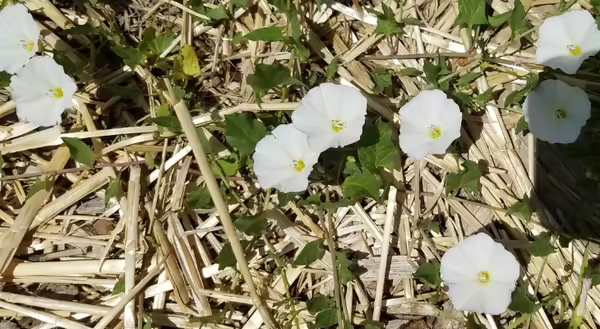
Occasionally, a weed pops up that commands attention due to its aggressive habit. Action must be taken quickly to avoid its establishment in the landscape, or years of control efforts will ensue. Knowing when a tiny invading plant should be taken seriously can be difficult for a gardener. In many cases, some of these aggressive weeds can seem insignificant and small, or they may charm us with attractive flowers while their conquest of our garden space is imminent.
Field bindweed (Conovolvulus arvensis) is one of the worst offenders in the weed world and meets the description above as a sneaky invader that seems quite insignificant at first detection. It flowers throughout summer, and its white or pinkish, attractive flowers can be observed across the central Illinois landscape. From ag fields or vegetable gardens to turf and landscape settings, once this plant catches your eye, you’ll notice it everywhere.
Deceptive Sprout
Gardeners often overlook Bindweed due to its benign appearance when it first sprouts. This plant can begin as a harmless-looking, stringy sprout, but the root system quietly developing under the soil can grow into a behemoth. Roots are often noted to extend over 15 feet deep into the soil profile and can send up new sprouts incessantly, popping up as far as a dozen or more feet from the initial growing point.
While an insidious weed like this can be the bane of many, being a plant lover, I often marvel at the incredible abilities many of the plants we consider weeds possess. Field bindweed is able to grow in such a wide range of conditions and handle such harsh environments that it's a wonder that it hasn’t taken over the world. It does prefer full sun but can grow just about anywhere with enough sunlight.
Bindweed can exist among mowed turf, quietly spreading unnoticed until it begins to flower. This ability to handle a mechanical treatment as abrupt as mowing while competing with a root system as vigorous as turf is truly a marvel of plant ingenuity. Bindweed can even produce flowers within a turf stand while consistently being mowed. It can be a serious weed in agricultural areas, significantly impacting yield as its vine-like stems twist and engulf crops, challenging even our most advanced agricultural systems of intensive plant management.
Why is it so hard to remove?
So, what makes a weed like this such a menacing and persistent pest? In this case, the crux of this plant’s invasiveness lies in its extraordinary root development and multiple spread methods.
If you’ve ever hand-pulled bindweed, you have certainly been disappointed by the incredibly thin and dainty root that comes up with its above-ground growth. It typically snaps off easily and often doesn’t bring much additional root system.
While other weed roots seem dense and fibrous at the soil surface, bindweed roots are not, often seeming to be a single skinny root extending straight down into the soil. It’s nearly impossible to dig up, and pulling breaks the root off long before reaching the depths of the root system.
This perennial plant’s strategy is to establish deep roots underground and store energy to fuel resprouting in case the above-ground portion of the plant is disturbed. The roots follow natural paths of least resistance under the soil to tunnel downward and, when stimulated to resprout, may follow an entirely different path upward, sometimes moving laterally as well, which allows stems to appear out of nowhere and often far from the original plant that was pulled.
Segments of stem or root tissue as small as a few inches are known to root and grow new plants, which enhances its ability to spread. The trailing or climbing viney stems can spread along the soil surface under other plant cover or climb up and engulf competing plants or structures.
Bindweed is a prolific seed producer if allowed to flower and complete its lifecycle. Seeds have been observed to stay viable for decades in the soil profile, with some sources noting up to 50 years of viability.
Bindweed is an exotic invasive plant that warrants immediate control when detected. It is one of the most competitive plants I have ever dealt with and, upon establishment, may be a species that can only be managed as opposed to eradicated. Take this weed seriously and consider all options for control!
For more information about bindweed identification and control, please refer to the Home, Yard & Garden Pest Newsletter, Issue 6 from 2018.